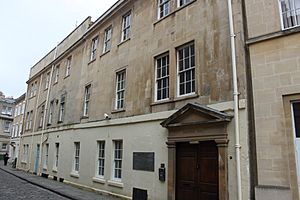Old Orchard Street Theatre facts for kids
Quick facts for kids Old Orchard Street Theatre |
|
|---|---|
 |
|
| Location | Bath, Somerset, England |
| Built | 1747-1750 |
| Architect | Hippesley and Watts |
|
Listed Building – Grade II
|
|
| Official name: Masonic Hall formerly Theatre | |
| Designated | 12 June 1950 |
| Reference no. | 1396228 |
| Lua error in Module:Location_map at line 420: attempt to index field 'wikibase' (a nil value). | |
The Old Orchard Street Theatre in Bath, England, has a long and interesting history. It started as a theatre, then became a Roman Catholic church, and is now a Masonic Hall. This historic building is protected as a Grade II listed building, which means it's an important part of England's heritage.
Contents
A Theatre for Bath
Bath had its first theatre in 1705. It was small and didn't make much money. This first theatre was later taken down in 1738. Another new theatre opened in Kingsmead Street in 1723 and stayed open until 1751.
Building a New Theatre
In 1747, an actor named John Hippisley suggested building a brand new theatre. He passed away soon after, but John Palmer, a local businessman, took over the plans. The famous city planner, John Wood, the Elder, chose the perfect spot for the theatre. It was built on the site of an old orchard near Bath Abbey.
Construction began in 1748, following designs by Thomas Jolly. The work was finished by John Powell in 1750. The theatre was about 60 feet (18 m) long and 40 feet (12 m) wide.
Opening Night and Royal Status
The theatre, first called The St James Theatre, opened on October 27, 1750. The first play performed was William Shakespeare’s Henry IV, Part 2. John Palmer was the manager.

In 1768, Palmer received a special permission from the King. This allowed the theatre to be called ‘Theatre Royal’. It was the first theatre outside London to get this special title! Palmer then gave control to his son, also named John Palmer.
Connecting Bath and Bristol
The younger John Palmer also managed the Theatre Royal in Bristol. Both theatres shared the same acting company. This meant actors, stagehands, and props had to travel quickly between Bath and Bristol. To solve this, Palmer created a special coach service. This service helped his actors and equipment move safely and efficiently.
Later, Palmer used this idea to create a countrywide mail delivery service for the Post Office. He managed the theatre until 1785. Then, he handed control to William Keasberry and William Wyatt Dimond. Many famous actors performed here, including John Henderson and Sarah Siddons. The theatre was used until 1805, when the current Theatre Royal opened.
The famous author Jane Austen knew the Orchard Street theatre well. It is thought to be the theatre she described in her book Northanger Abbey.
A Catholic Church
After being empty for four years, the building was changed into a Roman Catholic chapel in 1809. This was done by the leaders of Prior Park and Downside Abbey. The stage, gallery, and boxes were removed to make space for the church.
Growing Congregation
After the Roman Catholic Relief Act 1829 was passed, many rules against Roman Catholics were lifted. The chapel then became a full church. Important events like the ordination of bishops, including Peter Augustine Baines, took place here. The church also used the old scenery storage areas as stone tombs. About 286 bodies were buried there.
As the number of church members grew, a new church was needed. In the 1850s, Charles Francis Hansom designed and built St John's Church. In 1863, the church members moved to the new St John's Church. Most of the bodies from the vaults were also moved to the new churchyard.
A Masonic Hall
The building was empty again until 1866. That year, the Masonic Royal Cumberland Lodge bought it. They paid £636 to make it their meeting hall.
The building was damaged during the Baedeker Blitz in 1942. This was a series of air raids during World War II.
Today, the hall is still used by many Masonic groups for their meetings. It is also sometimes rented out for events and performances.
Images for kids


